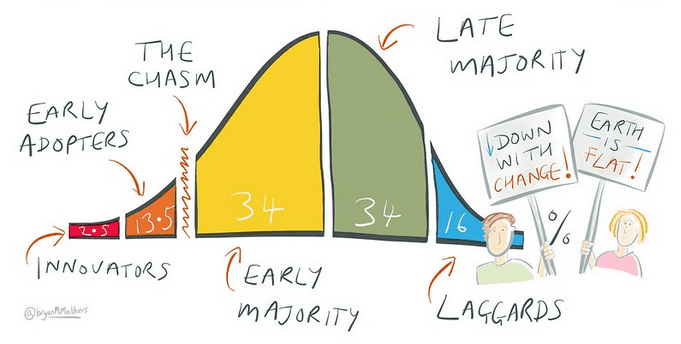The user experience (UX) in crypto is getting better. But it’s still a pain in the butt. The faster it improves, the faster we’ll move along the adoption curve—kind of how drinking your morning prune juice speeds up certain bodily processes. DeFi, specifically, is where usability is really painful. I mean, have you ever tried to use a DEX?
There are like a zillion steps you have to take just to figure out what steps you need to take. The user experience is almost as bad as trying to use any kind of government website. Half the reason crypto was created was to reduce transaction times, fees, and improve usability in legacy finance.
And yet, here we are.
But, you may be wondering what exactly UX is and how it is painful in crypto. User experience is not always easy to define. Some think of it as the aspects of design that take customer impression into consideration, others think of it more broadly as understanding and anticipating what will make a good overall experience for users.
Most of the time UX is strategized in the context of a single product but, as we’ll discuss, this is a consistent problem across the whole crypto industry, not just one dApp or platform. So, for our purpose, what is UX? Well, it’s everything.
Crypto exchange usability has improved…somewhat
 In the early days of Bitcoin, it was pretty complicated to get your hands on coins. Back then, there was no Coinbase or Bianance. Average investors had no clue how to get crypto, let alone exchange it for fiat.
In the early days of Bitcoin, it was pretty complicated to get your hands on coins. Back then, there was no Coinbase or Bianance. Average investors had no clue how to get crypto, let alone exchange it for fiat.
The best way to acquire those Bitcoins (and yes, full Bitcoins they were), was to mine them. That meant setting up your computer as a network node, likely upgrading your processor, and probably even making use of the dark web. Oof. That’s not as easy as tapping your watch at the register to pay for groceries.
Usability is a bit easier now, years later. There are some platforms that have been around for a while and have slowly improved the design of their products and overall experience. More and more people are also beginning to understand the basics of crypto, so the barrier to entry is lowering, slowly but surely.
Way back at the dawn of personal computers, engineers were the ones who understood them and were also the biggest user base. But as computing became more user friendly, the end customer needed to understand less and less about how it worked in order to use it. Today, how many of us really know how smartphones work? Not many, but that’s fine, we can still use them.
I believe this is how usable crypto needs to become before it crests the top of the adoption curve, as we progress from early majority to late majority acceptance.
 The big question is whether crypto can strike a balance between thoughtful usability and decentralized implementation since these two things are slightly at odds.
The big question is whether crypto can strike a balance between thoughtful usability and decentralized implementation since these two things are slightly at odds.
Centralized on-off ramps
 At the moment, the most user-friendly products in crypto are the big, centralized exchanges.
At the moment, the most user-friendly products in crypto are the big, centralized exchanges.
Anyone who owns crypto has likely used Coinbase or Binance; there’s a reason for that. But, though they’re flush with capital to improve design and UX, they are also less decentralized.
Here’s where centralized apps stand with UX.
They have decent UI
Both the Coinbase website and mobile app are fairly intuitive when it comes to user interface (UI). There are simple features for beginners on regular Coinbase and more advanced features on Coinbase Pro, allowing multiple types of customers to get the UI experience they want.
They’re understandable
If you have a basic knowledge of how trading works and what crypto you want to buy, knowing what you need to do on centralized exchanges is fairly straightforward. There are lots of guides and blogs available as well on websites like Gemini and Kraken.
They go offline
Even though they have the most pros, centralized platforms have cons too. A lot of the custodial crypto exchanges are liable to go offline during high trading times. This is frustrating to say the least. If you can’t buy the dip or sell when you want to sell, what’s the point of an exchange?
They often have restrictions
One aspect of usability that’s frustrating for end-users is geographic restrictions. Of course, regulation is the main reason for this, so it’s not completely the fault of platform design. But a user’s crypto experience is definitely impaired when they are georestriced from the most usable apps.
Customer service
Across the entire cryptosphere, customer service is a problem. All you have to do is search Reddit to find story after story of funds getting locked up, KYC issues, bugs, and password retrieval problems—few of which get fast or helpful resolutions. At the same time, however, some of the biggest players in tech like Google and Facebook are also notorious for poor customer service. It doesn’t make it any less frustrating, though.
DeFi dApps and DEXs
Once you’re out of the centralized exchanges, all bets are off in terms of UX. In addition to the obvious flaws in UI design that sometimes burns your retinas and makes you want to smash your phone, computer, and desk, there are more issues.
Snowballing fees
Granted, fees are not exactly a design problem. You’ll run into these suckers everywhere. But the decentralized and unintegrated crypto landscape exacerbates fees and makes predicting fees difficult. Gas fees are always changing and every DEX has its own trading and withdrawal fees.
Takes as long as legacy finance
A common talking point for crypto is that transactions can happen as fast as they’re confirmed on the network, unlike legacy finance where transactions take days. The reality, however, is that moving crypto often takes just as long and can be even more hazardous if you send the wrong type of token or input the wrong wallet address.
Gotta research which coins to use
There’s still a lot of education that’s left to the end-user in DeFi. If you want to know what types of coins are on which DEX, where they can be sent, and the coins with the lowest network fees, you generally have to poke around for info yourself. Platforms don’t make it easy to understand the intricacies of interoperability (or lack thereof).
Accessing the decentralized web
If you’re using a DEX or a dApp, you’ll likely need a browser that can access the decentralized web. Things like MetaMask and Brave browser make this possible, but navigating them is not as smooth or feature-rich as Chrome, for example.
Connecting and enabling a gazillion things
Because the whole crypto ecosystem still lacks integration and interoperability, there’s a lot of connecting various applications, and it’s not immediately obvious how to do so. Prepare to search for guides on connecting wallets to DEXs, layer-2s, DeFi services, and more.
Passwords, seed phrases, 2FA
If you just explore, chaotically the way I do, it can be hard to keep track of everything. You need to know all your passwords and seed phrases and set up two-factor authentication (2FA) on everything—it’s a rat’s nest of permissions, which is ironic since permissionlessness and disintermediation are goals of crypto.
Stuff is buggy
Even if you’ve figured out what you need to do and how, there’s always the question of whether it will work smoothly. There are still lots of bugs in many dApps and platforms that can send you screaming out of the room, pulling your hair.
Attempts to ease usability
As a fledgling industry, it’s understandable that UX is still taking shape in DeFi and crypto in general. There is an awareness that more integration and usability needs to be achieved. Like I said before, though, it’s largely coming from centralized companies.
This, itself, can damage user experience for an audience who wants decentralized alternatives to legacy investing tools.

Coinbase is adding dApp support
The CFO of Coinbase says it’s planning to support third-party DeFi apps so that users don’t have to choose between so many platforms—they can meet all their DeFi needs within the Coinbase app. Centralizing access is good for ease-of-use but not so great for…well, decentralization.
Robinhood and retail
If you remember the GameStop snafu with r/wallstreetbets back in early 2021, you know how popular Robinhood became for retail investors. Nowadays, Robinhood is trying to popularize crypto trading as well. Just note that crypto bought on Robinhood cannot be sent out, only sold.
Square is making a DEX
The company that popularized on-the-go credit card payments is now looking to expand into crypto with its own DEX. Jack Dorsey and company want to become an easy on-off ramp for users looking to exchange fiat and crypto.
Summary
There are still a lot of pain points in the user experience of crypto. Even though usability has come a long way since the early days, there’s a reason most retail investors use centralized exchanges and don’t bother moving their coins into a self-custody wallet. UX is still cumbersome and annoying. To invest in some of the altcoins that you want, you’ll need to do some research about which DEX to use.
How will the industry balance true decentralization with ease-of-use going forward? Is it possible? Part of what’s attractive about crypto is its unregulated and decentralized nature. Here’s hoping UX design can evolve to increase adoption without sacrificing security and privacy.
About the Author

Michael Hearne
About Decentral Publishing
Decentral Publishing is dedicated to producing content through our blog, eBooks, and docu-series to help our readers deepen their knowledge of cryptocurrency and related topics. Do you have a fresh perspective or any other topics worth discussing? Keep the conversation going with us online at: Facebook, Twitter, Instagram, and LinkedIn.


